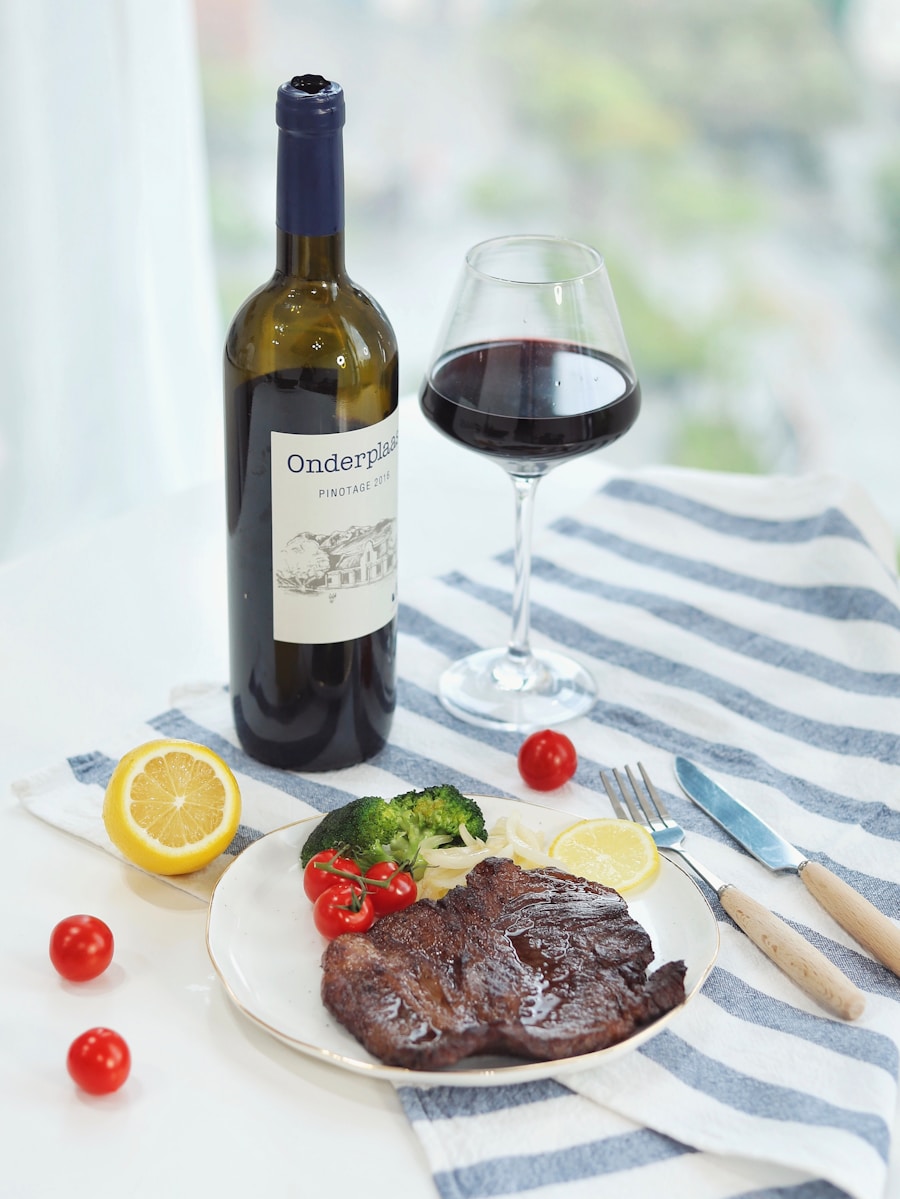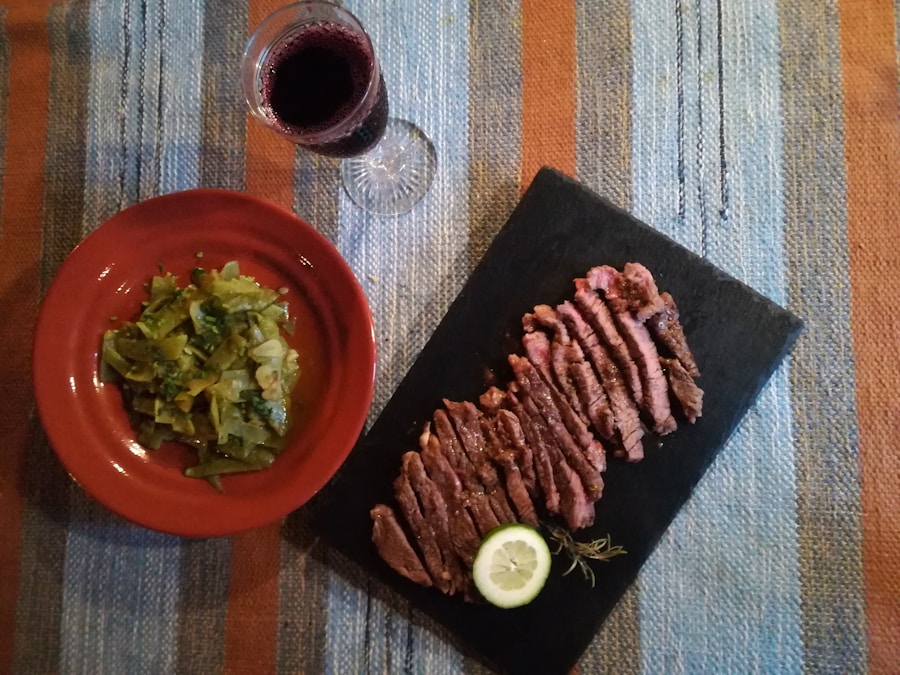When delving into the world of steak and wine, it is essential to first understand the various types of steak available and how they can influence the choice of wine. Steaks are typically categorized based on the cut of meat, which can significantly affect their flavor, tenderness, and overall eating experience. Common cuts include ribeye, filet mignon, sirloin, T-bone, and flank steak, each offering a unique profile.
For instance, ribeye is known for its marbling and rich flavor, making it a favorite among steak enthusiasts. In contrast, filet mignon is prized for its tenderness and subtle taste, often appealing to those who prefer a more delicate meat experience. The choice of wine is equally diverse, with red and white wines offering a plethora of options.
Red wines, such as Cabernet Sauvignon, Merlot, and Malbec, are often favored for their robust flavors that can stand up to the richness of red meat. On the other hand, white wines like Chardonnay or Sauvignon Blanc can provide a refreshing contrast to certain steak dishes, particularly those that are grilled or served with lighter sauces. Understanding these basic elements sets the stage for exploring the intricate relationship between steak and wine.
Key Takeaways
- Understanding the Basics: Types of Steak and Wine
- The Science Behind the Pairing: How Flavor Profiles Complement Each Other
- Choosing the Right Wine: Tips for Selecting the Perfect Bottle
- Red Wine and Steak: Exploring the Classic Pairing
- White Wine and Steak: Surprising Pairings that Work Well Together
The Science Behind the Pairing: How Flavor Profiles Complement Each Other
The art of pairing steak with wine is not merely a matter of personal preference; it is rooted in the science of flavor profiles. Each type of steak possesses distinct characteristics that can either enhance or clash with the flavors found in various wines. For example, the umami flavor present in well-cooked steak interacts beautifully with tannins in red wine.
Tannins are compounds found in grape skins and seeds that contribute to the wine’s astringency and structure. When paired correctly, the tannins in red wine can soften the richness of fatty cuts like ribeye or porterhouse, creating a harmonious balance on the palate. Moreover, acidity plays a crucial role in this pairing dynamic.
Wines with higher acidity can cut through the fat in steak, providing a refreshing counterpoint that elevates the overall dining experience. For instance, a zesty Cabernet Sauvignon can complement a juicy sirloin by enhancing its savory notes while simultaneously cleansing the palate between bites. Understanding these scientific principles allows diners to make informed choices that enhance their enjoyment of both steak and wine.
Choosing the Right Wine: Tips for Selecting the Perfect Bottle

Selecting the right wine to accompany steak involves several considerations that go beyond mere preference. One fundamental tip is to consider the cut of meat being served. For instance, when enjoying a rich ribeye steak, a full-bodied red wine like a Cabernet Sauvignon or a Syrah can be an excellent match due to their bold flavors and tannic structure.
Conversely, if one opts for a leaner cut like filet mignon, a softer red such as Pinot Noir may be more appropriate, as its lighter body and fruit-forward profile will not overpower the delicate flavors of the meat. Another important factor is the cooking method used for the steak. Grilled steaks often develop a smoky flavor that can be complemented by wines with similar characteristics.
A Malbec or Zinfandel can enhance this smokiness while providing a fruity counterbalance. Additionally, considering any sauces or seasonings used in preparation is vital; for example, a steak topped with a rich béarnaise sauce may pair well with an oaked Chardonnay that mirrors the creaminess of the sauce.
Red Wine and Steak: Exploring the Classic Pairing
| Wine | Steak |
|---|---|
| Red Wine Varieties | Types of Steak |
| Merlot, Cabernet Sauvignon, Malbec, Syrah | Ribeye, Filet Mignon, New York Strip, T-bone |
| Flavor Profile | Flavor Profile |
| Rich, bold, fruity, tannic | Rich, savory, charred, juicy |
| Best Serving Temperature | Best Cooking Method |
| 60-65°F (15-18°C) | Grilled, pan-seared, broiled |
| Recommended Pairing | Recommended Pairing |
| Medium-bodied Merlot with ribeye | Cabernet Sauvignon with filet mignon |
Red wine has long been celebrated as the quintessential companion to steak, and for good reason. The robust flavors and tannic structure of many red wines create an ideal synergy with various cuts of beef. Cabernet Sauvignon stands out as one of the most popular choices due to its full-bodied nature and complex flavor profile that includes notes of dark fruit, cedar, and spice.
This wine’s high tannin content makes it particularly well-suited for fatty cuts like ribeye or T-bone, where it can effectively cut through the richness while enhancing the meat’s natural flavors. Merlot is another excellent option for steak lovers seeking a softer alternative to Cabernet Sauvignon. With its velvety texture and fruit-forward profile, Merlot pairs beautifully with leaner cuts such as sirloin or flank steak.
The wine’s lower tannin levels allow it to complement rather than overpower the meat’s flavors. Additionally, exploring varietals like Malbec or Syrah can introduce exciting new dimensions to traditional steak pairings. Malbec’s dark fruit notes and peppery finish make it an excellent match for grilled steaks, while Syrah’s boldness can enhance the savory qualities of marinated cuts.
White Wine and Steak: Surprising Pairings that Work Well Together
While red wine is often regarded as the go-to choice for steak, white wine can also create delightful pairings that challenge conventional wisdom. The key lies in understanding how certain white wines can complement specific cuts and preparations of steak. For instance, a well-structured Chardonnay can work surprisingly well with grilled steaks, especially when accompanied by buttery sauces or sides.
The wine’s creamy texture and notes of vanilla can mirror the richness of dishes like steak with béarnaise sauce or garlic butter. Another unexpected pairing involves Sauvignon Blanc, which offers bright acidity and herbal notes that can enhance grilled flank steak or skirt steak seasoned with chimichurri sauce. The zesty character of Sauvignon Blanc cuts through the richness of the meat while highlighting its savory qualities.
Additionally, sparkling wines such as Champagne or Prosecco can provide an effervescent contrast to steak dishes, making them an intriguing choice for those looking to break away from traditional pairings.
Beyond the Basics: Exploring Unique Wine Varietals with Steak

As diners become more adventurous in their culinary explorations, unique wine varietals are gaining popularity as exciting companions to steak. For example, Tempranillo—a Spanish varietal known for its earthy undertones—can create an exceptional pairing with grilled steaks seasoned with spices or served alongside roasted vegetables. Its medium body and balanced acidity allow it to complement both leaner cuts and richer preparations.
Another varietal worth exploring is Grenache, which offers bright fruit flavors and subtle spice notes that can enhance dishes featuring peppercorn sauces or herbaceous marinades. This versatile wine pairs well with various cuts of beef, from sirloin to flank steak, making it an excellent choice for those looking to experiment beyond traditional options. Additionally, lesser-known varietals like Sangiovese or Barbera can provide unique flavor profiles that elevate the dining experience when paired thoughtfully with steak.
Enhancing the Experience: Tips for Serving and Enjoying Wine with Steak
To fully appreciate the pairing of wine with steak, attention to detail in serving and enjoying both elements is crucial. Temperature plays a significant role; red wines are typically best served at room temperature (around 60-65°F), allowing their flavors to fully develop. Conversely, white wines should be chilled (around 45-50°F) to maintain their refreshing qualities.
Proper glassware also enhances the experience; using appropriate glasses allows for better aeration and aroma concentration. When it comes to savoring both wine and steak together, taking time to appreciate each element individually before combining them can heighten enjoyment. Start by tasting the wine on its own to identify its flavor profile before taking a bite of steak.
This approach allows diners to notice how each component interacts on the palate—how the wine’s acidity balances the richness of the meat or how certain spices in the dish bring out hidden notes in the wine.
Experimenting with Pairings: How to Find Your Perfect Combination
Finding the perfect pairing between steak and wine is often a journey of experimentation rather than a one-size-fits-all solution. Encouraging diners to explore different combinations based on personal preferences can lead to delightful discoveries. One effective method is to host a tasting event where various cuts of steak are paired with an array of wines—both red and white—allowing participants to sample different combinations and share their thoughts on what works best.
Additionally, keeping a journal or notes on successful pairings can help individuals refine their preferences over time. Documenting which wines complemented specific cuts or preparations allows for future reference when planning meals or dining experiences. Ultimately, embracing experimentation fosters a deeper appreciation for both steak and wine while encouraging culinary creativity in pairing choices.



